
| Capital | : Yangon |
| National Population | : 52 million |
| Language | : Myanmar |
Chiefly inspired by ancient Indian tradition, Myanmar arts has evolved to its present delightful diversity and artistically absorbing forms. Periods reaching amazing creative heights and productivity include the Pagan empire with over 2,000 magnificent pagodas, the birth of modern Myanmar dance during the Kingdom of Inwa, and the Konbaung Dynasty with its new artistic creation of architecture, sculpture and Zatgyi (dance drama).

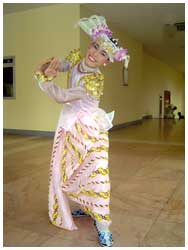
Myanmar theatre, like its people, is incredibly colourful, pleasantly humorous, very lively and very likable - one of South East Asia’s most captivating.
Myanmar folk love to watch a classical "from mid night-to-sunrise" drama known as Zat. This "village theatre" is well attended by all in the family, young and old, with their mats, snacks and tea. This all-night- long drama is usually held during the pagoda festival.
Another intriguing drama is the Yamazat - a Myanmar version of the Ramayana epic. Performed by well trained actors, principal characters wearing masks except Thida, include Prince Yama, Prince Lakhana the younger brother, Princess Thida, Dasagiri, the ten-headed ogre and Hanuman, the monkey.
Marionette theatre which originated during the Bagan period and developed in the reign of King Singu in the eighteenth century is a highly skilled art form. Some of the puppets have as many as sixty strings and even movable eyebrows. While the puppet masters manipulate the puppets (twenty eight characters in all), male and female impersonators sing and recite the parts.
Myanmar dance, existing from pre-Buddhist times is of two types - soft, supple, slow and graceful type, as well as, quick and vigorous type. In traditional dances, the male and female dancers do not touch each other when dancing together. This technically outstanding performance coupled with the beautifully adorned and colourful costumes, is a fascinating and breathtaking experience to savour.
Traditional theatre dramatics are backed by a Myanmar ensemble of drum circle, gong circle, bamboo clappers, wind instruments, flute and cymbals. In addition, a large drum, hung also include from an ornamental winged mythical creature called "Pyinsayupa" and the melodious soothing l3- string harp. Unlike Western music, Myanmar music is atonal, basing on the pentonic scale similar to the Indonesian gamelan and equally appealing.

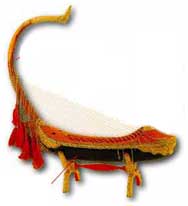
Classic products of an ancient heritage with an enduring charm, are the arts and crafts of the Golden Land. Among Myanmar’s many crafts are silk and cotton weaving, lacquerware, gold and silver work, wood, bone and marble carving, tapestry and pottery - each a world of knowledge and a learned art form.
Lacquerware is an ancient craft, yet very much alive in the regions of Bagan and Kyaukka village, near Monywar. The tedious and painstaking process involves coating, drying and numerous re-coating of a framework of woven bamboo over a period of months, climaxing with the amazing delicate task of etching designs by hand and then dyeing of colours onto the lacquered article.
Tapestries made of applique designs on velvet or cotton cloth with glass beads and shining sequins stitched on, fashioned into pretty items such as jackets, hats or handbags are popular souvenirs for travellers. Delightful motifs include dancers, elephants, peacocks and mythical animals of Myanmar culture. Scenes from Jataka stories (stories about Buddha’s previous existence) are depicted on large wall hangings.
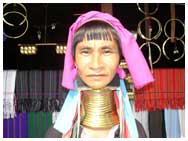 Paduang Woman |
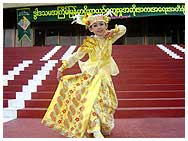 Myanmar Traditional Dance |
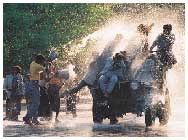 Myanmar New Year |
(Source:myanmartravelsandtours.com)










